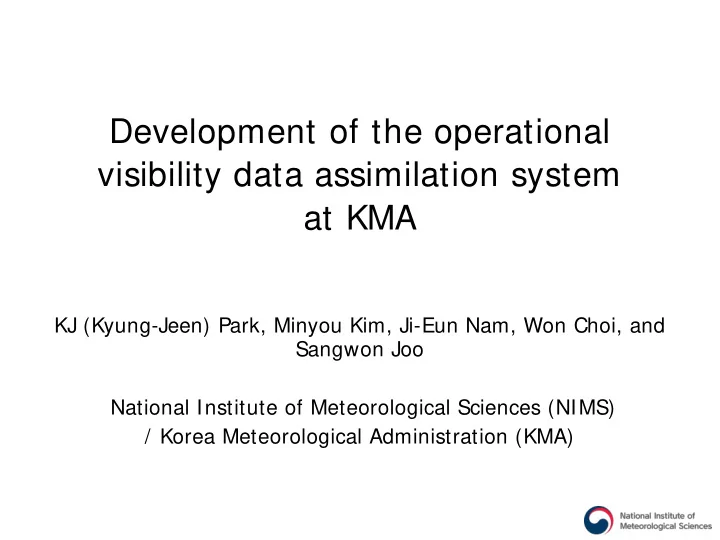

Development of the operational visibility data assimilation system at KMA KJ (Kyung-Jeen) Park, Minyou Kim, Ji-Eun Nam, Won Choi, and Sangwon Joo National Institute of Meteorological Sciences (NIMS) / Korea Meteorological Administration (KMA)
Outline • Motivation • New Very-Short Range Forecast system • Quality control • Data Assimilation • Experiment results • Summary and plans
Motivation Deaths per 100 car accidents (in Korea) clear= 3.3, cloudy= 4.4, rain= 4.1, fog= 11 , snow= 4.2 Test operation of Fog special report (since 2010) expected less than 200 meter visibility for more than 2hours Data Visibility observation network Assimiiation 238 over South Korea
Main Operational NWP Systems at KMA GLOBAL Global EPS • Resolution • Resolution N512 N768L70 N320L70 (~ 25 17km (~ 40km/ top = 80km) / top = 80km) • Target Length • Target Length 240hrs 252hrs (00/12UTC) • IC : GDAPS 72hrs (06/18UTC) • # of Members : 24 • 4DVAR E-ASIA LOCAL • Resolution • Resolution 12kmL70 (0.11 ° x0.11 ° / top= 80km) 1.5kmL70 (744 × 928 / top = 39km) • Target Length • Target Length 72hrs (6 hourly) 36hrs • Initialization : 4DVAR Main NWP Suites in KMA • Initialization : 3DVAR
Very-Short Range Forecasting System
Very-Short Range Forecasting System : Time windows
Visibility : Observation Visibility observation network instrumental measurement : 238 points including 22 regional office Vaisala Biral OSI Belfort I nstrument PWD22 VDF-730 OWI -430 VisWx 6550 Measurement method Foreward scattering Scattering 45˚ / 850nm 42˚ / 880nm angle/ wavelength Range of measurment 10m ~ 20km 10m ~ 75km 10m ~ 50km 6m ~ 80km 1.3% (600m) 10% (10m~ 10km) 10% (10m~ 5km) 10% Measurement error 2% (2km) 15% (10~ 20km) 15% (10km~ ) (entire range) 10.5% (30km) 7 precipitation 4 precipitation Present weather 3 aerosol detection 49 WMO code 15 WMO code 50 WMO code 10 WMO code Num. of instrument 52 25 84 22 Made in Finland U.K. U.S. U.S.
Visibility : Observation error < 15km |log(VIS obs ) - log(VIS true )| ~ 0.25 root mean square 1.3 ~ 15% visibility ratio : 1.5-2 REF: Prediction of visibility and aerosol within the Met office UM, Clark et al., 2008, QJRMS
Vis observation : correlation with Vaisala Belfort, r= 0.92 Biral, r= 0.91 OSI , r= 0.64 REF: Analysis of visibility observations, Y Lee, K Kim, J Ha, and E Lim (2016)
Spatial / temporal variabilities temporal variability spatial variability visibility : 1 min avgerage visibility(5min) 10 min avgerage No background, buddy, consistency check !!!
Visibility Q.C. : Precipitation check Precip. Check In case of precipitation, reliability of visibility observation decreases. The model does not consider precipitation in the calculation of visibility. → Visibility data must be removed if there is precipitation.
Visibility Q.C. : Range check visibility obs no no Obs. (RH, T, P) exist? background: RH, T, P yes VIS min = f (aerosol max , RH , T, P) VIS max = f (aerosol min , RH, T, P) no VIS min < visibility < VIS max yes flagged QC passed (not assimilated) (assimilated)
Visibility Q.C. : Range check Period : Feb (1 month) + Mar (22 days) 2016 old QC modified QC • All visibility data must pass range check using obs. or background RH, T, P .
Visibility D.A. : visibility operator
Visibility D.A. : minimization (single obs. Exp) Cost function Gradient • Nonlinear visibility operator basic state is updated during minimization working well ??
Visibility D.A. : Single Observation Test murk q total T U V • Issues - Decorrelation length scale? - murk correlation
Case study visibility OBS With Vis DA Without vis DA analysis
Equitable Threat Scores Period : Feb (1 month) + Mar (1 week) 2016 No Vis DA VDAPS : 1-hour cycling with VIS DA, LDAPS : 3-hour cycling without VIS DA • VDAPS shows higher ETS for the events with visibility under 2 and 5 km. • For fog events (visibility less than 1 km), both models show poor ETS
Summary and plans Summary - implemented operational visibility DA into VDAPS at KMA - developed the background based quality control - case/cycling experiments improve vis forecast but still low ETS scores for low vis. - Issues aerosol (one total aerosol, no LBC), measurements errors, background error covariance, double loop performance On-going works - operation (Oct. 2016) - Improvement of low vis DA (errors, aerosol , double loop, B) Future plan - 4DVAR - aerosol sources - lateral boundary conditions (Global: 2 species, VDAPS: 1 specie) - vis. obs. operator (more than 2 species) 19
Recommend
More recommend